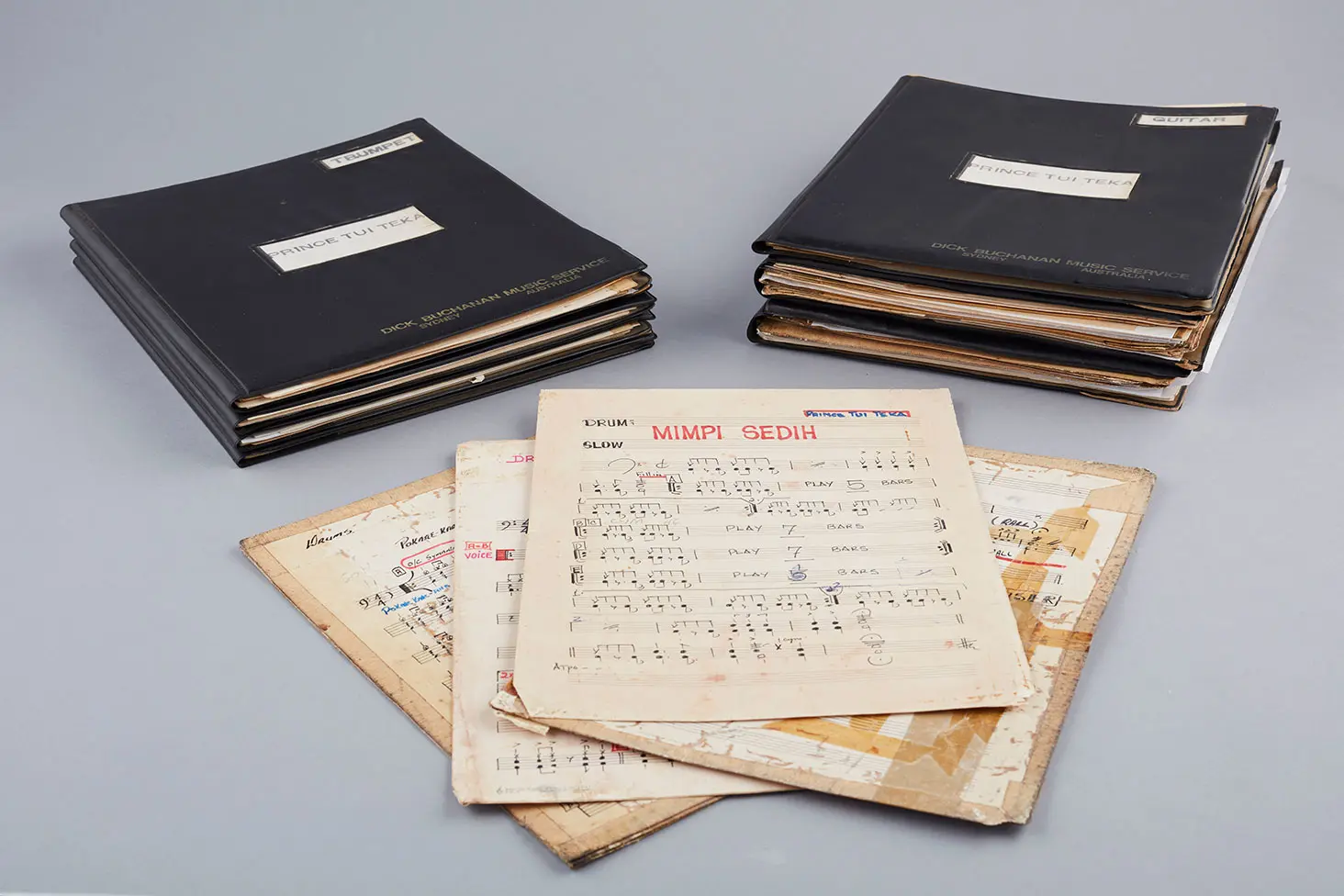Prince Tui Teka’s well-worn folios of musical arrangements testify to a busy life on the road.
Image credit: Folios of musical arrangements, 1972–85 by Tumanako (Tui) Teka. Ref: MSZ-1758_MSZ-1762_MSZ-1757_001_mm Alexander Turnbull Library.

Prince Tui Teka’s well-worn folios of musical arrangements testify to a busy life on the road.
Image credit: Folios of musical arrangements, 1972–85 by Tumanako (Tui) Teka. Ref: MSZ-1758_MSZ-1762_MSZ-1757_001_mm Alexander Turnbull Library.

Prince Tui Teka was one of Aotearoa New Zealand's great 20th-century musical talents. He became well known for his television show and the 1982 hit song ‘E Ipo’ (‘My Darling’). Find out, and explore our collections and curated resources.
Tumanako Teka (Ngāi Tūhoe; 1937–1985), also known as Prince Tui Teka, was one of the entertainment greats of Aotearoa New Zealand. He spent his early career touring Australia with Wirth’s Circus and the Māori Troubadors showband, then the world with the Māori Volcanics. In 1972, he brought his talents home, going solo, becoming a household name through his television show and the 1982 hit song ‘E Ipo’ (‘My Darling’), and contributing to a crucial time in the revival of te reo Māori.
The folios of band arrangements used by Teka’s bands of the 1970s and 1980s — for piano, guitar, bass, drums, alto and tenor saxophone, trumpet and trombone — document his eclectic repertoire. They include country (‘Before the Next Teardrop Falls’), rock ’n’ roll (‘That's All Right’) and doo-wop (‘Only You’), with comic improvisations (‘The Stripper’), showcases for his trumpet playing (‘Il Silenzio’) and waiata Māori (‘Hoki Mai’). ‘I’m middle of the road,’ he once joked. Heavily worn, repaired with tape and marked up with stage cues, the folios testify to a busy life on the road. It is fortunate that they have survived at all. The Turnbull Library purchased them at auction in 2019.
Versatility epitomised the performance of Māori showbands, one of the country’s prime musical exports in the mid-twentieth century. Combining variety with musical virtuosity, humour and Māori culture, groups such as the Māori Hi-Five, the Quin Tikis and the Māori Volcanics wowed audiences at hotels and cabarets around the world. Teka performed with the Volcanics in 30 different countries, across Europe, the Middle East and Southeast Asia, including for soldiers in South Vietnam. Ironically, the showbands' international success was unknown to most New Zealanders at the time.
Māori showbands picked up songs and invented new musical ‘cocktails’ along the way, a process documented in Teka’s band arrangements. Teka’s signature song ‘E Ipo’ employs the melody of ‘Mimpi Sedih', an Indonesian love song written by Aloysius Riyanto that became popular after it featured in the 1973 movie Akhir Sebuah Impian. The lyrics were written by the renowned te reo Māori songwriter Ngoingoi Pēwhairangi (Ngāti Porou; 1921–1985). They concern Teka’s love for Ngoingoi's niece and Teka’s wife, Missy Kururangi.
Teka’s folios include parts for ‘Mimpi Sedih’ arranged by Danny Francisco, a Filipino musician who conducted orchestras in Malaysia during the 1970s. Pencilled on one part is a later annotation indicating that it should be used for backing ‘E Ipo’, while a fresh set of charts made specifically for ‘E Ipo’ shows its emergence as a New Zealand classic.
Story written by: Michael Brown
Copyright: Turnbull Endowment Trust
Image credit: Prince Tui Teka, cover from The Maori Album (Ode SODE 080), 1975 (detail). Photographer unknown. Reproduced courtesy of Terence O’Neill Joyce (Phono q Lc7777). All rights reserved. Used with permission.

Read connected stories from Te Kupenga:
Explore the Alexander Turnbull Library collections further: Prince Tui Teka.
Topic Explorer has:
Many Answers has Ngā pūoro Māori (Māori music).
Want to share, print or reuse one of our images? Read the guidelines for reusing Alexander Turnbull Library images.
Tikanga ā-iwi:
Te whakaritenga pāpori me te ahurea
Te ao hurihuri
Te wāhi me te taiao
Ngā mahinga ohaoha.
Te Takanga o Te Wā (ngā hītori o Aotearoa):
Whakapapa
Tūrangawaewae
Mana motuhake
Whanaungatanga.
Social sciences concepts:
Identity, culture, and organisation
Place and environment
Continuity and change
The economic world.
Aotearoa New Zealand’s histories:
Māori history is continuous
Colonisation and its consequences
Relationships and connections between people.